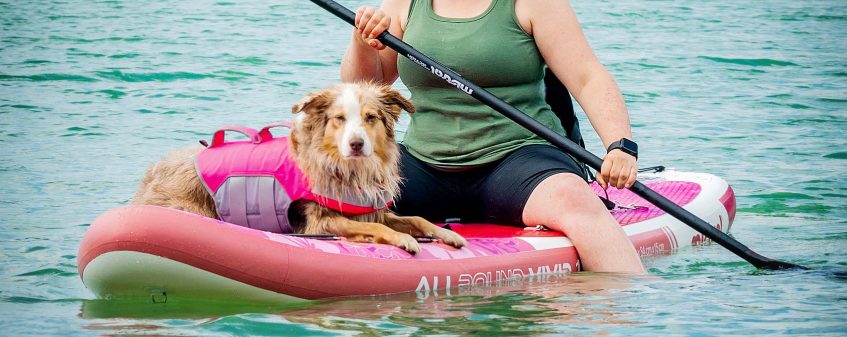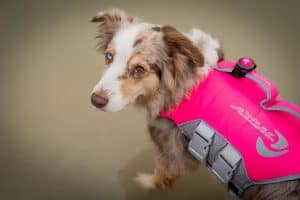Summer is the perfect time to enjoy the water with your furry friend on a dog-friendly watercraft. Before heading out, it’s important to ensure a safe and enjoyable experience for both you and your pup.
These suggestions will keep the tails wagging and guarantee a fantastic and safe time for everyone, whether your dog is joining you on the boat, kayak, canoe or stand-up paddleboard.
Before hitting the waves
Introduce your dog to waterFirst and foremost, it’s important to ensure that you are comfortable in the water and confident in your swimming and paddling abilities. If your dog is not an experienced swimmer, it’s crucial to introduce it to the water in a safe and controlled environment such as a pool, pond or the ocean on a wave and wind free day. To help your dog gain confidence in the water, have it practise swimming in its dog life jacket before your first boat outing. It’s also important to note that not all dogs are natural swimmers , and some may need more practice to feel comfortable in deeper water. Train your dog on dry landBefore getting on the water, it’s best to train your dog on dry land first. Show it how to navigate the watercraft, get in and out, and stay put while you get in and out yourself. This will help your dog feel more comfortable and prepared for the adventure ahead. |
 |
Get a pawdicure
One often overlooked aspect of boating with dogs is keeping their claws trimmed. When your dog’s claws are in good shape, it helps it maintain good traction on the often-slippery surfaces of boats, kayaks and paddleboards. This, in turn, helps it maintain its balance and avoid injuries. To further enhance your dog’s grip, you can also use traction mats made specifically for paddleboards, inflatable kayaks and sit-on-top kayaks. Some canoers even line the bottom of their craft with a yoga mat or fake lawn mat for added grip.
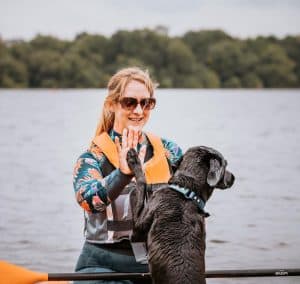 |
Consider your dog’s breed and endurance levelAn in-depth knowledge of your dog is crucial when it comes to boating with it. It’s important to take its breed, age, size and endurance level into account when choosing a boat for it. Consider whether it will be comfortable sitting on a paddleboard or if a tandem dog kayak with an extra seat would be a better choice. Smaller dogs may prefer to be closer to you in the boat, while larger dogs may require more space and flexibility to stand up or lie down comfortably. If your dog is new to swimming or being around watercraft, it’s important to evaluate how it typically reacts to new experiences. Has it shown ease around water in other settings? Will it be able to ignore exciting stimuli that may cause it to want to jump overboard? If your dog is anxious, consider how it will handle loud, fast-moving whitewater. Overall, knowing your dog’s individual needs and preferences is essential for ensuring a safe and enjoyable boating experience for both you and your furry friend. |
Ensure your dog is obedient and trained for watersports
Before taking your dog out on the water, it is important to ensure that it has been trained with obedience and voice commands. Teaching commands such as “leave it”, “stop”, “sit” and “down” can be crucial in emergency situations.
A well-trained dog will be more likely to stay in your kayak or maintain balance on your paddleboard. It is recommended to train your dog to sit, lie down, and follow your other commands before going out on the water.
Additionally, it is important to be mindful of distractions onshore, as they can cause your dog to lose focus. Have a clear command that lets your dog know when it is safe to jump off the boat.
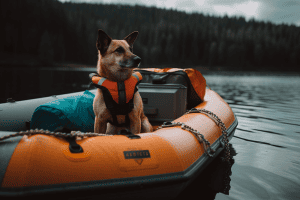 |
What to bring?Ensure you have the following items on hand for a safe and enjoyable outing with your furry friend. Adventure checklist for dog water sports:
Ensure your dog’s safety while on the water by investing in a canine life jacket and a personal flotation device (PFD) for yourself. Canine life jackets provide a safe and effortless way to keep your pup afloat, requiring much less energy to paddle compared to swimming on its own. For added security, attach a waterproof safety light to your dog’s life jacket to make it more visible in waves and low-light conditions. Keep a leash handy for onshore activities, but avoid using it in the water as it can become a hazard. Instead, opt for a dog life vest with a handle that allows you to grab your dog quickly and easily in case of an emergency. Remember to protect your dog from the sun’s harmful rays by applying sunscreen – especially if it has a sensitive nose or fair skin. Exposure to sunlight can also damage its vision over time. Consider getting a pair of doggy sun goggles for added eye protection. Don’t forget to bring fresh water, a bowl and treats for your pup during outings. Drinking water from lakes or saltwater can be harmful to your dog’s health, so make sure to provide it with a source of fresh water to avoid dehydration. To make sure your pup is happy and obedient while on the water, bring a bag of dog treats as a motivational tool. This is especially important if your dog is new to boating or water activities. In case of accidents, a first aid kit is crucial for both you and your furry friend. Pack essentials like gauze, non-stick tape, waterproof booties to keep paws dry and tweezers for removing pests like ticks or leeches. To keep your dog entertained, bring some water-friendly toys onboard. This will give it something to do and help it burn off steam. Fetch is a great game to encourage independent swimming and paddle practice. Opt for toys that float and are easy for your dog to see. |
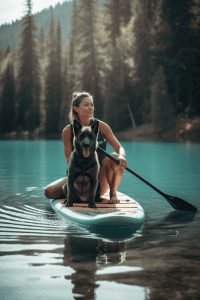 |
On the waterWhen getting on the boat, take it slow and steady. If your dog seems nervous or panicky in shallow water, consider it a training opportunity and try again another day. Remember, boating with your pup should be a fun and enjoyable experience! To ensure your pup stays safe while swimming, make sure it has plenty of opportunities to rest and access shade. A life vest can also provide support and make it easier for you to assist your furry friend if it becomes tired or needs help to stay afloat. When it comes to boating with your dog, safety should always be your top priority. Avoid tying your pup to the kayak or boat, as there are numerous ways this could become dangerous, such as capsizing or the leash becoming tangled. What if your dog goes overboard?When travelling with dogs in a boat, on a paddleboard or in a dog-friendly kayak, there is a risk that you could capsize or, in other ways, unintentionally end up in the water. In the event that your dog does go overboard, it’s important not to panic. Your furry friend will be looking to you for guidance and help. Be prepared with a plan for dog-overboard scenarios, and share it with anyone joining you on the water. |
Consider investing in a life jacket with a safety light to help you locate your pup even in low-light conditions or choppy waters. With proper gear and training, you and your four-legged friend can enjoy a safe and enjoyable day of boating together.
Stay safe out there!

Share this: #orbiloc #orbilocsafetylight
 English
English Deutsch
Deutsch Dansk
Dansk
